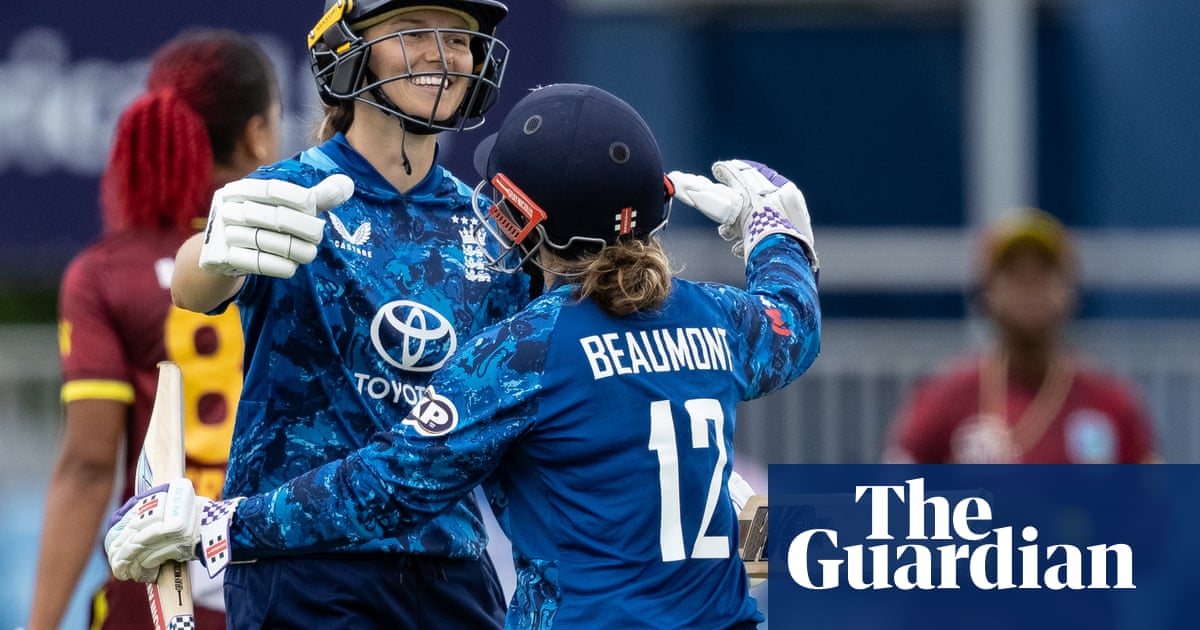England took advantage of the absence of Hayley Matthews to thrash West Indies by 143 runs in the second ODI at Leicester on Wednesday.
Having waited 12 years to score a maiden international hundred, Amy Jones resolved to achieve the feat twice in five days, and this time did so in just 76 balls; while Tammy Beaumont followed up with a second consecutive hundred of her own. The decision of the head coach, Charlotte Edwards, to reunite the pair after a five-year break now looks like a masterstroke after they became the first players in ODI history to share consecutive partnerships of more than 200.
Matthews had been ruled out before play due to a shoulder injury, presumably sustained after carrying the entire weight of her team all tour. She spent the England innings stalking the boundary in a sling;it seems unlikely that she will be able to play any part in the final ODI at Taunton on Saturday.
West Indies were also without their hard-hitting opener Qiana Joseph, who is suffering from flu, but the 20-year-old Realeanna Grimmond proved a ready replacement, striking a 64-ball half-century on ODI debut.
Grimmond seemed surprisingly unfazed at being asked to open, even when she was struck on the forearm by a ferocious Lauren Filer, who clocked 75mph in her first international match since the Ashes. The young West Indian batter clobbered Lauren Bell for two sixes over the leg side, before finally holing out to long-on in the 23rd over.
Kate Cross then became just the eighth Englishwoman to reach the milestone of 100 wickets in ODIs, with a little bit of help from DRS – UltraEdge concluding definitively that she had caught the under-edge of Aaliyah Alleyne’s bat on the way through to Jones behind the stumps. Cross sat out the entire winter’s Ashes series with a back injury, and has admitted she felt her international career might be over, stuck forever on 98 ODI scalps; this felt like vindication for all those hours spent in agonising rehab.
West Indies were always going far too slowly to ever be at risk of achieving their target, but they made the England bowlers sweat for their series win: two DRS reviews burned; two catches shelled; a wild onslaught of 44 from 24 balls by Jannillea Glasgow; and a defiant tail, which saw 69 runs added between the fall of the seventh and tenth wickets – 44 of them in boundaries. Finally, in the 46th over, Alice Capsey had Cherry-Ann Fraser caught at point and the celebrations could begin.
If Amy Jones’sfirst international hundredhad been all stuttering relief, her second oozed grace and timing. She admitted on the eve of this match that she had been disappointed, five years ago, to be bumped down into the middle order by the then coach, Lisa Keightley, and that she felt the opening role suited her: “Having the chance to set the tone is a really cool responsibility.”
Sign up toThe Spin
Subscribe to our cricket newsletter for our writers' thoughts on the biggest stories and a review of the week’s action
after newsletter promotion
She certainly set the tone here, dominating a 202-run partnership with Beaumont, who was battling a bad cold and looked much the more restrained of the two, despite freebies aplenty from the West Indian bowlers. Jones reached 129 from 97 balls before sending up a return catch to Karishma Ramharack in the 30th over; it took Beaumont another eight overs to bring up her own ton.
Emma Lamb was presumably Edwards’s other contender for the ODI opening spot, but – assuming things continue like this – now needs to get used to sitting around for extended periods before her services are required at No 3. Here, with Jones back in the dugout, she contributed a nifty knock of 55 from 45 balls, while aggressive cameos from Sophia Dunkley and Capsey helped England accelerate at the death – albeit not quite at the rocket speeds promised in the early overs.
Grimmond had shelled a chance offered up by Jones on 43, diving forward at point, but redeemed herself somewhat in the death overs, safely snaffling two impressive catches in the deep as England were left 13 runs short of their record ODI total – although still with far more than they were ever likely to need.
